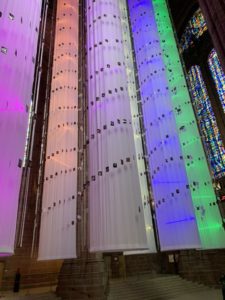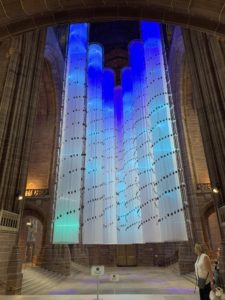Peter Walker’s Identity exhibit is currently on view at Liverpool Cathedral.
Here’s what Liverpool Cathedral has to say about it:
“IDENTITY introduces seven illuminated columns, suspended over the Well. Each column is lit, with individual strips of light representing the double helix of DNA and demonstrating the unique make up of each person. Together, the seven columns represent our distinct differences, gathered in union.”
“IDENTITY’S visual impact is supported by its ability to change colour throughout its stay at the cathedral, powerfully representing symbols of various communities and our shared values as well as individuality, including our ethnicity, gender and sexuality. We look forward to welcoming everyone and celebrating our identity.”
The artist, Peter Walker, comments on the exhibit:
“The placement of DNA is all about bringing an element of science into the building and it’s really just about connecting. That’s right at the center of who everyone is. We all have DNA strands and the double helix is part of all of us.”
“The sculpture explores the concept of who we are, what defines us as a person or within a collective group. Our identity may be shaped by characteristics we are born with such as” eye color, race, gender or characteristics which develop over time; our personality, interests, and beliefs.”
“The Sculpture explores the fascinating similarities and differences we all have in one unique exploration into who we are, what face we choose to show the world, what it means to be an individual, and asks what it means to be part of a community in a wider context.”
“The number 7 was symbolic in ancient literature, religion, and culture, and it has the meaning associated with ‘completeness’ and unity with the four corners of the earth and the holy trinity. There are 7 fruits of the spirit, 7 deadly sins.”
A Christian critique:
- DNA is something we all share.
This is undeniably true. The more we learn about DNA, the more fascinating it is to contemplate this miniature library inside our cells.
The unifying principle of humanity, however, is not merely the shared “double helix”. The Bible tells us God created us, male and female, in his image. With the imago dei stamped upon us, we are uniquely created personalities. Humanity is more than a genome. The idea of shared DNA seems to be utilized in the exhibit as a unifying concept, but does the knowledge of shared DNA truly give us a greater sense of belonging?
Paul wrote to the Philippians: “Complete my joy by being of the same mind, having the same love, being in full accord and of one mind.” In the Christian faith, being unified and of “one mind” has nothing to do with biology. The unity of the New Testament is “unity of the Spirit in the bond of peace.” (Eph. 4:3) To the Corinthians, Paul says, “I appeal to you, brothers, by the name of our Lord Jesus Christ, that all of you agree, and that there be no divisions among you, but that you be united in the same mind and the same judgment.” How? By aligning our minds and judgments with God’s word. Christian unity comes by believing and obeying what God has said. It’s not enough for Christians to claim shared DNA, we must share fidelity to live as God has instructed us to live, and to love others.
- DNA makes us each unique.
This is also undeniably true.
DNA makes each human person one-of-a-kind-without-duplicate. However, our uniqueness is not determined only by genetics. We are more than our DNA. When John the Evangelist writes to his friend, he begins: Beloved, I pray that all may go well with you and that you may be in good health, as it goes well with your soul.
He acknowledges the two-fold nature of humanity: body and soul. The Bible teaches us we are not only bodies, but embodied souls, and our souls live on after the death of our physical bodies. We are more than DNA.
- DNA gives us our identity.
When biological evolution is accepted as the explanation for life, the reduction of all things to chemistry and biology is inevitable. Notably, this reductionist view of identity works in opposition to the exhibit’s stated goal. If our identity is nothing more than varied arrangements of four chemical bases, what is there to celebrate?
Importantly, Walker seems to conflate immutable physical characteristics we are born with, such as eye color, with mutable behaviors/personality traits. DNA does determine the former, but in matters of behavior and personality, it’s not that simple. The reduction of identity to DNA undermines the possibility of biblical repentance, spiritual formation, and moral accountability by implying DNA is the primary, or even the sole factor that shapes what we do, think, and believe over time.
We should also note Walker’s use of the term “gender”. While he claims to bring an “element of science” into the cathedral, he denies basic biology by using the term “gender” as a substitute for biological sex in his list of characteristics people are born with. But we are not born with “gender” as it is defined by gender theorists (a construct of the mind); we are born with a biological sex which is either male or female. His use of the term is ambiguous, at best, since the term “gender” has been hijacked to subvert identity.”[1]

Conclusion:
On a positive note, the exhibit does communicate the idea that all human beings have inherent value; People are valuable individually and communities are special collectives of shared values and beliefs. Unfortunately, what the exhibit gets right, it fails to justify or explain.
No matter how large the installation is, it cannot make up for the smallness of its reductionistic views of humans and humanity. Even Walker’s strained reference to the number 7 and medieval Catholic doctrine cannot prop up meaning for viewers since nothing in the exhibit clearly connects or explains these references.
This exhibit could have been persuasive.
Liverpool Cathedral and Peter Walker could have acknowledged the impossibility of such complex information in our DNA (a computer program!) assembling inside our cells by accident. They could have used the exhibit as an apologetic for special creation and the teachings of the Bible. Instead, Liverpool Cathedral and Peter Walker never mention how God created us, nor do they give him thanks. Sadly, in this once-sacred space, the praise due to the Creator is given to the creature instead.
This exhibit could have been powerful.
Additionally, they could have used our knowledge of DNA to promote the sanctity of unborn life, as each preborn child has all the DNA needed for a complete, unique human person. That would have been a powerful and biblical message of unity and diversity. Instead, Liverpool Cathedral and Peter Walker chose to promote the revolutionary rainbow of values which fights to eradicate human value in the womb, including our tiniest special needs neighbors.
This exhibit could have been truthful.
They could have used the exhibit to tell the truth about human sexuality. Instead, they incorporated the false narrative that sexual behavior is coded into our DNA. This is false and misleading. Sexual behavior is a choice.
If you want to know what it means to be human, neither Liverpool Cathedral nor Peter Walker’s IDENTITY can help you.
But God can.
[1] Sharon James, Gender Ideology, 24-25.


